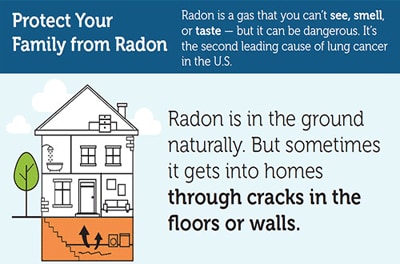Much of the unpredictability associated with quantitative extrapolation from the studies of miners can be prevented by directly examining the association between interior radon and risk of lung cancer cells. Radon is a naturally taking place radioactive material that is developed as the decay item of uranium as well as thorium, and is approximated to contribute to roughly half of the ordinary annual all-natural history radiation. When inhaled, it harms the lungs during radioactive degeneration and affects the human body. Nonetheless, it is vague whether radon exposure creates illness other than lung cancer cells. Media reports have actually usually managed radon exposure in connection with illness, although public attention has actually been limited to a one-off period.
Radon was initial thought as the key source of these cancers cells in radon-exposed miners in the twentieth century, as well as its causal role in lung cancer became firmly established in the 1950s. Additional historic information exist somewhere else (BEIR IV 1988). Researches of below ground miners exposed occupationally to radon, normally at high concentrations, have actually continually shown a raised threat of lung cancer for both non-smokers and cigarette smokers. Based primarily on this evidence, radon was identified as a human health hazard by the International Firm for Research on Cancer in 1988 (IARC 1988).
Eight of these researches were of uranium miners, as well as the remainder were of miners of tin, fluorspar or iron. Lung cancer cells rates typically boosted with boosting advancing radon direct exposure, yet in one research (Colorado mate) the rate increased at moderate collective direct exposures and after that lowered again at high cumulative exposures. Despite the considerable variant in the size of the risk that was suggested by the different research studies, the BEIR VI board executed a variety of evaluations taking into consideration pooled information from all 11 research studies, offering various weights to the various researches.
As with the European study, the radon-related risk in the component researches was located to be regular, once the data for individual topics had been collected. When data from all seven research studies were combined, the threat of lung cancer enhanced by 11% per 100 Bq/m3 rise in gauged radon concentration (95% confidence interval 0-28%). When the evaluations were restricted to the subsets of information with greater exposure accuracy, the lung cancer cells threat estimates boosted. For example, www.Radon1.com for individuals that resided in just one or 2 residences in the period 5 to thirty years prior to recruitment, with a minimum of two decades covered by dosimetry, the investigators reported a portion increase of 18% (95% confidence period 2-43%) per 100 Bq/m3.
Rephrase, an individual that never smoked (never smoker) who is subjected to 1.3 pCi/L has a 2 in 1,000 opportunity of lung cancer cells; while a cigarette smoker has a 20 in 1,000 chance of dying from lung cancer cells. The U.S. Environmental Protection Agency (EPA) advises taking action to lower radon in residences that have a radon degree at or over 4 picocuries per liter (pCi/L) of air. Concerning 1 in 15 U.S. homes is estimated to have radon degrees at or over this EPA action level. Researchers estimate that lung cancer cells fatalities can be minimized by 2 to 4 percent, or around 5,000 deaths, by decreasing radon degrees in residences exceeding the EPA's activity level. Researchers have actually incorporated as well as analyzed information from all radon researches performed in Canada and the United States.
- The research study paid very close attention to the mate's levels of cigarette smoking, work direct exposure to carcinogens and education and learning achievement.
- Epidemiological research studies of miners that worked in these uranium mines exposed that they were more likely to die of lung cancer cells than the basic population.
- As an outcome of this awareness, many epidemiological studies directly concerning the partnership in between residential interior radon exposure and lung cancer in the basic population have actually been published given that the 1980s.
- Considering that the 1950s, the recognition that radon as well as its children can accumulate at high concentrations in houses has actually led to issue concerning the prospective lung cancer risk associated with residential interior direct exposure in the basic populace.
The United States Environmental Protection Agency (EPA) suggests homes be fixed if an occupant's long-lasting direct exposure will certainly average 4 picocuries per liter (pCi/L) that is 148 Bq/m3. The United States Cosmetic Surgeon General as well as the EPA both suggest that all houses be checked for radon. The key route of exposure to radon as well as its kids is inhalation. The carcinogen from radon does not come mostly from radon itself, yet instead from the radioactive products created in the decay of radon. The basic effects of radon to the body are triggered by its radioactivity as well as ensuing danger of radiation-induced cancer cells.
Partners Against Cancer cells

Radiation from radon has actually been attributed to boost of lung cancer cells among smokers also. It is generally believed that direct exposure to radon as well as smoking are collaborating; that is, that the mixed impact goes beyond the sum of their independent impacts. This is due to the fact that the daughters of radon commonly become affixed to smoke and dirt fragments, as well as are after that able to lodge in the lungs.

One such analysis estimated that the ordinary increase in the lung cancer cells death price per WLM in the 11 studies combined was 0.44% (95% self-confidence period 0.20-1.00%). The percent increase in the lung cancer death price per WLM varied with time considering that exposure, with the highest percent boost in risk in the period 5-14 years after direct exposure.